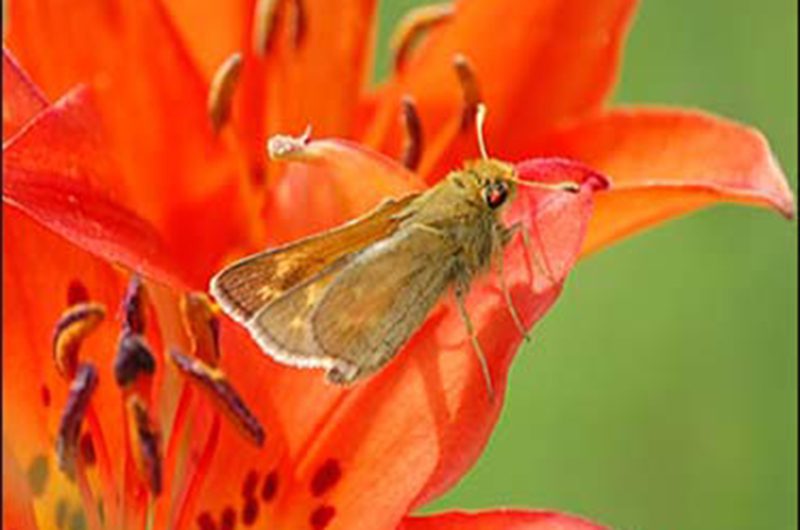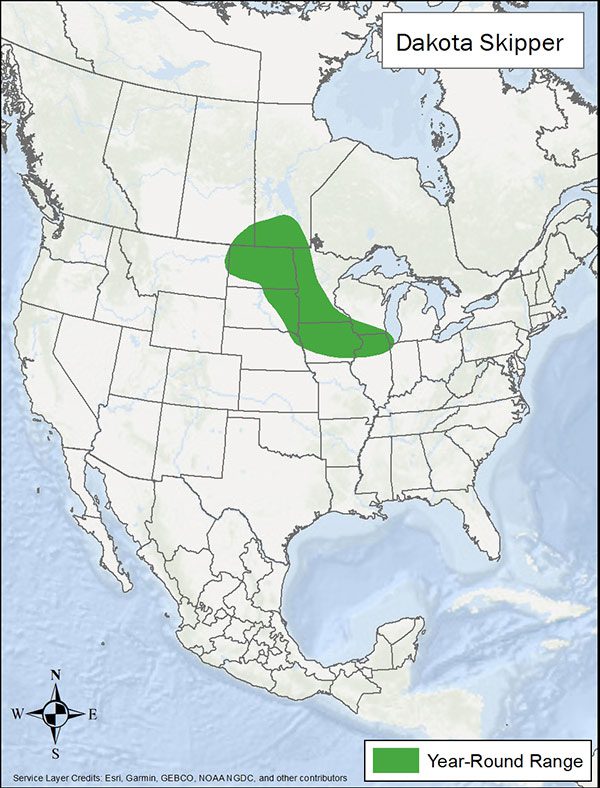LandPKS Learning
Habitat Hub

Dakota skipper
Dakota skippers spend most of their life as larvae or caterpillars from approximately late July until the following June or July. After hatching, larvae form shelters of silk at the base of grass plants and construct larger shelters as they grow. Dakota skipper larvae overwinter either in these shelters or in buried shelters.
Hesperia dacotae
Identification
The Dakota skipper is a small to medium-sized butterfly with a wingspan of 0.9-1.3 in/2.4-3.2 cm. The wings of the adult male are tawny-orange to brown on top, with a prominent mark on the forewing. The underside of the male’s wings is dusty yellow-orange. Females have darker brown with tawny orange spots on the top of their wings and a few white spots on the margin of the forewing. The underside of the female wings is dusty gray-brown with a faint white band of spots across the middle of the wing. Dakota skippers have hooked antennae. The larvae are light brown with a black collar and dark brown head. The species remains in the caterpillar stage for approximately one year. Dakota skipper is listed as Threatened in the United States and Endangered in Canada.
Observation Tips
Dakota skipper is found in northcentral United States into southern Saskatchewan and Manitoba. These butterflies make a single flight each year from the middle of June to the end of July. The flight depends upon temperature and can vary from year to year.
Interesting Fact
Dakota skippers spend most of their life as larvae or caterpillars from approximately late July until the following June or July. After hatching, larvae form shelters of silk at the base of grass plants and construct larger shelters as they grow. Dakota skipper larvae overwinter either in these shelters or in buried shelters.
Ideal Habitat
Dakota skippers live in high-quality mixed and tallgrass prairie remnants. These butterflies rely on diverse native grassland plant communities, and human caused and natural disturbances. Dakota skippers prefer unplowed native prairie on dry to mesic calcareous gravelly soils. The larvae feed on many native prairie grasses, often little bluestem, big bluestem, needle-and-thread, and porcupine grasses, with little bluestem being the most commonly used grass. Adults utilize a variety of native nectar flowers, including blackeyed Susan, prairie lily, wood lily, bluebell bellflower, mountain death camas, white prairie clover, purple coneflower, oval-leaf milkweed, hoary vervain, purple locoweed, and prairie milkvetch. The most common species used were blackeyed Susan and purple coneflower. In tallgrass prairie, canopy height should be >8 in/20 cm.

Range map provided by International Union for Conservation of Nature
Management Activities that Benefit Species – Best Management Practices (BMPs)
Maintain intact high-quality mixed and tallgrass prairies. Disturbance is necessary to maintain prairie plant communities as it prevents woody plants from encroaching and invasive species from establishing. If conducting prescribed fire for tallgrass prairie management, ensure burn plans also consider the needs of Dakota skippers. Conduct careful monitoring for the presence of Dakota skippers to leave portions of the occupied habitat protected from fire each year. Burns should be conducted in very early spring as most larvae are below ground or under cool or damp conditions and are more likely to survive.
If haying is happening in occupied habitat, delay until late in the season, rather than early summer or mid-summer. Invasive species management should take an integrated approach that recognizes the presence of Dakota skipper and manages in compatible ways.
Light to moderate grazing, especially in tallgrass prairie sites is thought to be beneficial for Dakota skipper. In mixed grass prairie, even moderate grazing should be done carefully. In general, grazing in a manner that improves or maintains native prairie using a rotational system with portions of the site rested each year and with varied timing will minimize adverse impacts to Dakota skipper.
Management Activities to Avoid
Avoid conversion of high-quality mixed and tallgrass prairie to cropland, hog farms, or residential development. Avoid planting of native tallgrass prairie to tame nonnative grasses. Avoid late spring through fall burns, especially where there are moderate to high fuel loads, as most larvae are killed during these burns. Avoid pesticide use in grasslands.
Other Species that Benefit from Similar Habitat Management
Management for Dakota skipper will benefit many tallgrass prairie species including Ottoe skipper.
Download
Download the Dakota skipper fact sheet
Other Resources
International Union for Conservation of Nature (IUCN). 2014. The IUCN Red List of Threatened Species. Version 2021-1 Dakota Skipper
NatureServe. 2021. NatureServe Explorer: An online encyclopedia of life [web application]. Version 7.1. NatureServe, Arlington, Virginia. Dakota skipper
USFWS. 2018 Species status assessment report for the Dakota skipper (Hesperia dacotae).
Mobile App | Data Portal | Knowledge Hub | Habitat Hub | Learning Collections | Blog | About | Contact | Support



